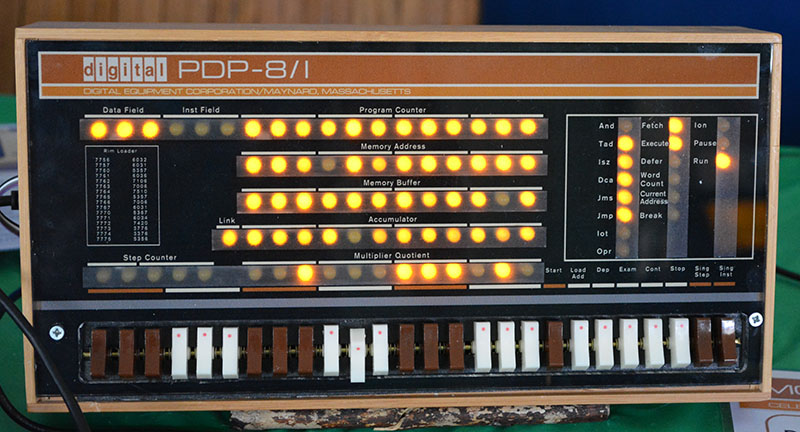The Vintage Computer Festival in Wall, New Jersey doesn’t just attract locals; [Oscar] came all the way from Switzerland to show off his PiDP-8/I. It’s a miniature minicomputer, emulated in SimH, with blinkenlights and toggle switches mounted to a Raspberry Pi Hat.
Although the PiDP-8 is emulating a machine with thousands of discrete transistors, the design is exceptionally simple. On the board is 92 LEDs, a bunch of diodes, 26 toggle switches, a driver chip, and that’s about it. All the multiplexing for the switches and LEDs is taken care of in software. On the Raspberry Pi side, [Oscar] is able to run FOCAL, OS/8, and, like a normal-sized PDP-8, can toggle in programs manually.
Instead of having connecting to the ribbon cables coming out of RK01 disk drives and DECtapes, [Oscar] is emulating those too. All the files that would reside on old Digital storage mediums are now stuffed into USB thumb drives. A USB hub is plugged into the Pi, and when one of these USB disk packs is plugged into the hub, loading an operating system or a program is just a matter of flicking a few toggle switches.
[Oscar] has been working hard to turn the PiDP-8 into a kit, and the word around the booths is that this will happen sometime this summer. The expected price for this kit is very interesting: somewhere between $100 and $150 USD. For that price, we’d expect someone to rig up an Arduino-based paper tape reader very quickly, perhaps this afternoon.
More pics and a video of the PiDP-8/I below.



















That looks fun, Very nice build.
Looks cool to me too :) I’m a retrotech kinda guy tho so maybe I’m a little biased. Maybe. I dunno.
The PDP-8 computers were initially based upon DTL – diode transistor logic Integrated Circuits then later via TTL MSI (medium scale integrated circuits) logic circuits. See: http://en.wikipedia.org/wiki/PDP-8 and for reference and further reading.
let me google that for you
(so this is a box where people leave opinions and comments)
Shuddup and take my money!
Beautiful build, and a great writeup on the actual blog, http://obsolescenceguaranteed.blogspot.ch/2015/01/new-project-pdp-8i-replica.html
hackaday.io may be a nice alternative for some, but when the real blog is available, I’m not sure why this sparse io page is favored over it.
Oh, and while I’m at it, please oh please dear god fix the io login page. Why there is still user & pass fields with only signUP options is beyond me. It’s easier to sign up then sign in, and I’m seeing this inexplicable trend in more then one site. Even on the menu, signup is more prevalent then sign in.
’nuff of that, this is truly a gorgeous build!
That could be a real blast in IT classes. It combines a very clever RPi design (worth studying in itself), great modeling and a practical experience of computing history, even down to the software.
Now can I get a laser to burn 9 holes across a paper tape, or will I use a 2D laser machine to cut out a card and ‘punch’ holes in it?? mmmm! I hope they put a lab coat when they use it.
Anyone know of a good source of those long-bladed paddle switches, so we can turn this into a Nova/Eclipse? :-)
Well, those rocker-style switches match what the original 8/I used, so for “authenticity” they are correct. But I prefer the lever type (not so much “paddle”) switches on the other PDP-8 models such as the 8/L that I learned on in the 70s. A similar type are also used on the Spare Time Gizmos SBC-6120 project which uses the actual Harris 6120 PDP-8-on-a-chip at its center. But the SBC-6120 is only meant to copy the 8/E, which had just two rows of lights and a selector switch. BOOOORRRRRIIIINNGGGGG!!!! Despite being less “real,” this project gets the stamp of approval from this true 1970s PDP-8 programmer, and I’ll have to make sure I’m in line to get one of the kits when they are available. Meanwhile, I would check into the toggle switches used for the SBC-6120 as they are more appealing – and far easier to use! – even if less “authentic.”
Small error: This has 89 LEDs.